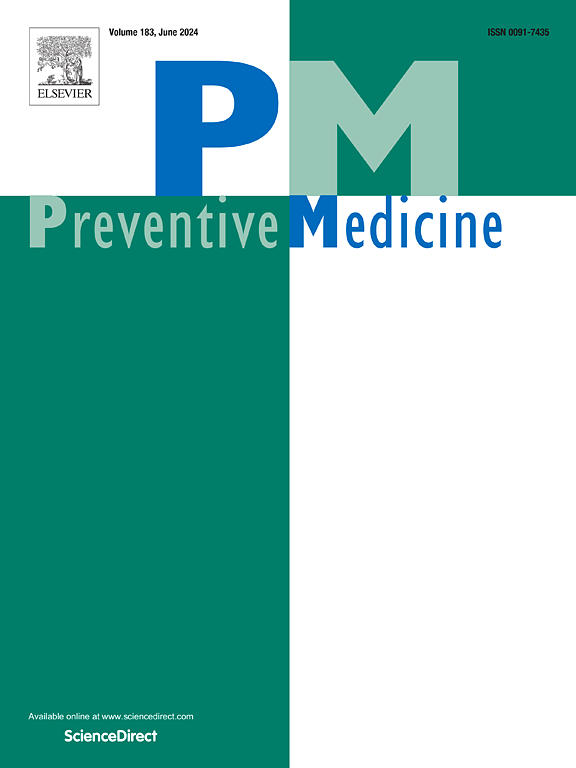Barriers to healthcare utilization among adults engaging in heavy drinking: Results from the all of us research program
IF 3.2
2区 医学
Q1 MEDICINE, GENERAL & INTERNAL
引用次数: 0
Abstract
Objective
We examined sociodemographic factors associated with barriers to healthcare utilization (HCU) among a national sample of adults engaging in heavy drinking behavior (HDB).
Methods
A sample of 3257 participants from the All of Us program (2018–2022 Controlled Tier Dataset-v7) who reported HDB (i.e., six or more drinks on one occasion, at least weekly) was selected to examine the associations between socio-demographic factors and barriers to HCU (i.e., structural, competing social roles, attitudinal, and financial barriers). Multiple logistic regressions estimated adjusted Odds Ratios (aOR) for the associations of interest.
Results
Financial barriers (23.64 %) were the most common of the four barriers, followed by attitudinal (18.27 %), competing social roles (15.66 %), and structural (13.36 %) barriers. Females were more likely than males to report competing social roles (or = 1.56, 95 %CI = 1.28,1.90), attitudinal (aOR = 1.41, 95 %CI = 1.17,1.70), and financial (or = 1.41, 95 %CI = 1.19,1.68) barriers. Lower income (aOR = 6.71, 95 %CI = 4.77,9.56), and Non-Hispanic Black/African Americans (aOR = 1.39, 95 %CI = 1.04,1.85) showed higher odds of reporting structural barriers.
Conclusions
As many as one in four individuals who engage in HDB experience at least one HCU barrier, particularly women, those with low-incomes, and Non-Hispanic Black/African Americans. The findings highlight the need for implementation of evidence-based strategies among the identified populations to reduce HCU barriers, and ultimately, alcohol-related disparities.
酗酒的成年人利用医疗保健的障碍:来自我们所有人研究项目的结果
目的:在全国有重度饮酒行为(HDB)的成年人样本中,研究与医疗保健利用障碍(HCU)相关的社会人口学因素。方法选择来自All of Us项目(2018-2022 Controlled Tier Dataset-v7)的3257名报告HDB(即一次饮酒6次或更多,至少每周一次)的参与者作为样本,研究社会人口因素与HCU障碍(即结构性、竞争的社会角色、态度和财务障碍)之间的关系。多重逻辑回归估计了相关因素的调整优势比(aOR)。结果经济障碍占23.64%,其次是态度障碍(18.27%)、社会角色竞争障碍(15.66%)和结构障碍(13.36%)。女性比男性更有可能报告竞争性的社会角色(or = 1.56, 95% CI = 1.28,1.90),态度(or = 1.41, 95% CI = 1.17,1.70)和财务(or = 1.41, 95% CI = 1.19,1.68)障碍。低收入(aOR = 6.71, 95% CI = 4.77,9.56)和非西班牙裔黑人/非裔美国人(aOR = 1.39, 95% CI = 1.04,1.85)报告结构性障碍的几率更高。多达四分之一的HDB参与者至少经历过一次HCU障碍,尤其是女性、低收入者和非西班牙裔黑人/非洲裔美国人。研究结果强调需要在确定的人群中实施基于证据的战略,以减少HCU障碍,并最终减少与酒精相关的差异。
本文章由计算机程序翻译,如有差异,请以英文原文为准。
求助全文
约1分钟内获得全文
求助全文
来源期刊

Preventive medicine
医学-公共卫生、环境卫生与职业卫生
CiteScore
7.70
自引率
3.90%
发文量
0
审稿时长
42 days
期刊介绍:
Founded in 1972 by Ernst Wynder, Preventive Medicine is an international scholarly journal that provides prompt publication of original articles on the science and practice of disease prevention, health promotion, and public health policymaking. Preventive Medicine aims to reward innovation. It will favor insightful observational studies, thoughtful explorations of health data, unsuspected new angles for existing hypotheses, robust randomized controlled trials, and impartial systematic reviews. Preventive Medicine''s ultimate goal is to publish research that will have an impact on the work of practitioners of disease prevention and health promotion, as well as of related disciplines.
 求助内容:
求助内容: 应助结果提醒方式:
应助结果提醒方式:


